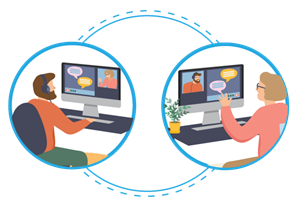Module 1: Designing for connection
1.6 Learner–learner connection: Designing authentic peer teaching and learning opportunities
Key principles: The importance of peer connection and collaboration in learning

Learner–learner connection takes place any time learners socialize, support one another, learn together, collaborate, or engage in discussion. Quality learner–learner interaction has great potential to create authentic connections and learning across all of Fink’s dimensions of significant learning:
- Foundational knowledge
- Application
- Integration
- Human dimension
- Caring
- Learning to learn
As with other aspects of online teaching and learning, many key decisions about how to cultivate learner–learner interaction are made during the design and development phase of a course.

Learner–learner interactions in online courses can be broken down into three basic types:
- Social and content-based interactions: discussions and colearning.
- Assessment-based interactions: group assignments and projects.
- Peer-to-peer teaching and assessments: presentations and peer feedback.
Key principles: Tools of communication and collaboration
There are many digital tools that can be used to facilitate learner interactions.
Tools of communication commonly found in LMSs:
- Text-based discussion in LMS forums (asynchronous)
- Email (asynchronous)
- Text chats in LMS (asynchronous or synchronous)
In addition to the traditional asynchronous exchange of text, modern online courses often feature other modern digital tools (also known as educational technology or EdTech tools) that allow learners to communicate in different ways.
Digital tools of communication typically external to LMSs:
- Threaded asynchronous video (e.g., Voice Thread, Flipgrid)
- Synchronous audio and video conferencing (e.g., Zoom, WebEx, Microsoft Teams)
- Learner blogs (e.g., Blogger, WordPress)
- Social media platforms (e.g., Twitter, Instagram, Facebook, TikTok)
- Peer-feedback platforms (e.g., peerScholar, PeerMark in Turnitin, Feedback Fruits, PeerWise, Aropä)
- Collaborative reading and annotation tools (e.g., Hypothesis, Perusall)
- Collaborative work/authoring software (e.g., Google Drive and suite of apps, suite of Office365 applications)
- Live engagement tools (e.g., Mentimeter, Kahoot!, Padlet)
Things to consider when choosing a tool
When selecting tools, it is important to think carefully and choose wisely. First and foremost, you will always want to design your learner collaboration activity before choosing the tool you want to use to make it happen. Choosing a tool first often ends up producing activities that are less effective than they could be. Sometimes the best activities use the simplest and least flashy tools, while other times the extra features of more powerful tools are crucial to making your activity work.
Once you have a plan for a great collaboration activity, the tools you select will affect the nature of learner communication and collaboration in many important ways. Thoughtful use of digital communication tools can really help to reduce transactional distance between learners, but the use of various communication and collaboration tools is a double-edged sword, as new tools can distract your learners, or introduce complexity or accessibility problems to your course that can increase barriers to communication. As Darby & Lang (2019) explain,
These are powerful tools—powerfully beneficial or powerfully distracting. Be purposeful.
(p. 70)
Here are some things to consider when selecting a tool for communication and collaboration:
- Is this tool necessary or can the same learning outcomes be achieved using tools within the LMS? Each new tool comes at a cost to learners, even if it is free, as they have to learn how to use that tool, navigate new interfaces, and find information in different places; is that cost necessary?
- How many tools are you asking your learners to use in your course? A good rule of thumb is your LMS plus one other tool or technology.
- Is the tool accessible to all learners, including those who are visually or hearing impaired? If the answer is no, you may be systematically excluding students. How will those learners be included and have the same opportunity to connect and learn with their peers?
- Is there a financial cost to you or your learners? Are there participant limits on free licences?
- Does the tool put your learners’ privacy or security at risk? Most tools that are recommended or centrally supported by your institution have likely gone through a privacy and security review and are the safest bet to ensure your learners are not exposed to risk using the tool.
Going deeper
If you are interested in learning about the top tools, the following resource is created each year:
The following rubric is a resource you may find helpful in evaluating tools and making the right decision for your course learning goals and outcomes:
Social and content-based interactions and discussions
Regardless of the medium or tool, social and content-based learner interactions all involve learners responding to a given prompt, exercise, or assignment in conversation with one another. This often takes places in asynchronous discussions using web forums, but can also occur using synchronous conferencing, as well as other tools such as asynchronous video discussions and beyond. What defines a “discussion” in our usage is that, for these types of interactions, the expected outcome of learner interaction is the interaction itself. By interacting, learners pool their resources to help advance their mutual understanding of key course content, and develop greater skills in analyzing and assessing course concepts. In addition, they get to know one another and build a greater sense of social cohesion and community in the course.
The purpose of discussion interactions may be content-oriented, purely social, or may mix the two. In general, purely social discussions take place early in the life of an online course, while content-based discussions tend to take shape a little later on, once learners have more knowledge under their belt.
Assessment-based interaction
Group assignments and projects are the most common form of this type of learner-learner interaction and if you’ve taught before, you’ll know that learners either love them or hate them. There are some common reasons learners do not enjoy “group work” and there are several ways to circumvent these pitfalls to ensure collaborative learning is a valuable and rewarding experience for most of your learners.
Secret ingredients to creating group assignments that are valuable and get learner buy-in
Peer-to-peer teaching and assessments
Peer-to-peer teaching and assessment interactions involve colearning (as do social and content-based interactions). However peer-to-peer teaching and assessments tend to be more formal or structured in that each learner has the opportunity to take the role of “teacher” and “learner” at different points or stages of an activity or assessment.
Peer-to-peer teaching gives learners the chance to essentially switch roles and see the content, their peers, and their own learning from the perspective of a teacher. Building in meaningful and authentic opportunities for learners to teach and learn from each other can be a powerful and memorable way of fostering the human and learning to learn dimensions of significant learning, as well as strengthening foundational knowledge, integration, and positive student attitudes toward learning (Zhang et al., 2017). Teaching their peers provides learners with unique insight into the content of the course and their own understanding. This approach can also build empathy for you, the instructor, as they step into your shoes.
Going deeper
Eric Mazur has done a lot of work on peer-to-peer instruction and has some helpful resources on his website.
Peer-to-peer assessment and feedback can help learners assess both their peers and their own work from a different lens. It is critical that learners are provided with instruction on how to assess and provide formative feedback that is constructive and sensitive and aligned with the assessment goals before engaging in peer-to-peer assessments and feedback. For example, demonstrate for them what supportive feedback looks like and what is inappropriate or can be hurtful. Providing learners with grading rubrics can be especially helpful in showing them how to assess others’ work as well as their own.
If you incorporate peer teaching and assessment into your course, consider framing these activities as ways to connect, support each other, and build the class learning community. Acknowledging that it takes courage for your learners to open up to peer teaching and evaluation can also help to validate some of the anxiety they may feel around these activities. Your learners are making themselves vulnerable when they evaluate one another, so acknowledge this and take extra steps to set expectations and guidelines that will help learners feel safe as they step outside their comfort zone.
Types of learner–learner interaction and associated activities
Social/content-based
Various forum types:
- introductions
- learning support (Q&A)
- topic discussions
- seminar discussions
- social chat
Other discussions and communication:
- threaded video discussions
- video or audio posts to course forums
- synchronous video or audio discussions
- social media
- interactive document collaboration
- emails, texts, and phone calls between students (typically not required but often take place informally)
Assessment-based
Types of major group projects:
- final papers
- reports
- studies
- reviews
- case studies
- software or coding projects
- prototypes/item builds
- group presentations
Types of group presentations:
- video presentations
- narrated slides or PowerPoints
- audio presentations
- public-facing presentations
- foreign language presentations
Other projects:
- short films and videos
- recorded role-playing scenarios
- creative and art projects
- podcasts
- blogs
- wikis
Peer review or assessment can be formal or informal, and it can be assigned as a part of nearly any course activity, using a wide variety of tools. Some examples for individual or group work includes
- feedback on written work,
- providing peer feedback using a rubric,
- feedback on presentations (can also be done so that learners can implement any changes ahead of formal evaluation),
- assessment of peers’ participation in the course discussions (usually confidential),
- reviews of other reviews (giving feedback on how helpful another student’s feedback was), and
- assessment of other group members’ participation in group projects (usually confidential).
Key principles: Aligning peer activities with the natural life cycle of learner–learner interactions
The role that learner–learner interaction plays in generating engagement and significant learning is not static during a course but changes as the course moves forward. Since the early days of online education, researchers have observed that learner–learner interactions in online courses typically go through three major phases (Brown, 2001; Downing et al., 2007):
- Socially formative phase, where learners get to know each other and form social bonds.
- Socially instrumental phase, where learners interact mainly to help one another learn course materials and (if required) work on projects together.
- Withdrawal phase near the end the course, when learner-learner interaction tends to wane, but their engagement and focus has typically increased but is directed towards final assessments. Note that anxiety levels tend to be higher around this time, which may also contribute to more withdrawal.
The role of learner–learner interaction with respect to learning and engagement differs between these various phases.

Learners get to know one another and form social bonds

Learners interact for the purposes of learning content and/or working on projects

Learner-learner interaction recedes somewhat as learners focus on final assessments, exams, etc.
Naturally, the dividing lines between the phases are not exact, but in general, you can expect learners’ desire to interact with each other will follow this basic sequence as the term progresses and it can be tremendously helpful to design your learner-learner interactions and assessments around this natural ebb and flow.
Going deeper
If you would like to read a little more about the life cycle of learner–learner interactions, you can find a more detailed summary here:
Further reading on this topic:
- Brown, R. E. (2001). The process of community-building in distance learning classes. Journal of asynchronous learning networks, 5(2), 18–35.
- Downing, K. J., Lam, T., Kwong, T., Downing, W., & Chan, S. (2007). Creating interaction in online learning: A case study. Research in learning technology, 15(3), 201–215.
Reflect and apply: Reflecting on our learner–learner interactions
Consider your experience with learner–leaner interaction. Perhaps you have
- taught a virtual course before,
- are working on your first course, or
- you have been a learner in a virtual course.
Regardless of where you find yourself, use the interactive tool to guide your reflection on the learner–learner interaction design and delivery. Complete the guided reflection in the table below and ensure to export your responses to your device once done.
- If you have taught a virtual course before and experimented with learner–learner interactions, make a list of interactions in your course and what you feel has gone well and what you feel did not go well or as planned.
- If you have not yet taught virtually and/or are working on your first course, make a list of some of your ideas for learner–learner interactions you are considering experimenting with in your first offer. Then, write out what you expect will go well and what you are worried may not go as planned.
- Alternatively, if you have been a learner in a virtual course with learner–learner interactions, you can complete this activity from the experiences you’ve had as a learner.
Then, considering the natural life cycle of learner interactions, does the timing of an interaction conflict or align with this natural ebb and flow of learners’ desire to interact with each other?
If interactions are not aligned with these phases, consider altering the format of early or later in the term assessments, for example switching a group assignment late in the term to an individual assignment with peer-to-peer assessment or switching an individual assignment earlier in the term to a group assignment but making sure to increase the scope and/or complexity of the assignment and group contract (also called a team/group charter) so it makes sense as a team project.
Learner–Learner Interactions Table (DOCX)
How to complete this activity and save your work:
Type your response to the questions in the box below. Your answers will be saved as you move forward to the next question (note: your answers will not be saved if you navigate away from this page). Your responses are private and cannot be seen by anyone else.
When you complete the below activity and wish to download your responses or if you prefer to work in a Word document offline, please follow the steps below:
- Navigate through all tabs or jump ahead by selecting the “Export” tab in the left-hand navigation.
- Hit the “Export document” button.
- Hit the “Export” button in the top right navigation.
To delete your answers simply refresh the page or move to the next page in this course.
Strategies in action: Designing meaningful social interactions and discussions
The following strategies foster
- connection: learner–learner, learner–content;
- significant learning (modelling): foundational knowledge, application, integration, caring, and human connection; and
- context: all (STEM, Arts, large class, small class, novice learners, advanced learners)
Designing meaningful discussions
Online discussion can have mixed results. Some online discussions foster authentic connections and help learners engage more deeply with course concepts and each other, while others fall flat and can feel like ‘busy work’ for learners. The design of online discussions and how they fit in with the course learning outcomes and goals, as well as how they work with other assessments in a course can make or break online discussions. Virtual discussion tends to be more meaningful and engaging when
- discussion questions are substantial enough that there is enough for each learner to share a unique perspective and they cannot be answered with simple facts;
- discussion questions provide opportunity for learners to draw on their own life or experience, a domain in which they have extensive experience and knowledge. This can help them see how concepts are personally relevant and gives them an opportunity to share something about themselves;
- learners are given time to prepare ahead of time (e.g., complete a reading or activity that enables them to think through the problem/question ahead of time); and
- learners are given space to engage. This means not overwhelming learners with in-depth weekly discussions (discussions are time-consuming) or having discussions in weeks where other assessments are due. Also, ensure you provide enough time for initial posts and responses. A single asynchronous discussion typically transpires over an entire week. Give learners a break in between discussions.
Going deeper
To learn more about how to design seminar and discussion-based courses see the following resource:
Graduate literature seminar discussion
This example is taken from a discussion forum in a graduate seminar course on the literature of Dostoevsky. In this case the forum explores theological and religious themes in the literature.
For this discussion assignment students have been asked during the previous weeks of the course to select their own readings from Dostoevsky’s novels with guidance from the instructor, rather than all students reading the same selections. Students then present their responses to their readings with a short but formal essay (graded separately from the forum). Discussion then follows as students ask questions, with each student serving as an expert on certain themes and sections that they have chosen to investigate.
By allowing students to select their own readings and choose which topics to discuss, and by having each student bring their own unique reading experience to the forum, discussion is allowed to flow in accordance with student interest. In the case of this course, the result was substantially improved student participation in the forum, and genuine collective learning through peer-to-peer teaching in which the instructor served primarily as a guide and students became content experts in their own right.
Intensive discussions like this are not appropriate for use in every single week of the course as they take a great deal of time. In this case, during the seminar discussion week students had no other required activities for the course except to post and discuss their essays. This allowed students to invest the time needed for deep collective learning in an asynchronous format. For larger courses, the students could be assigned into groups for a discussion like this one.
Credit: Dr. Daniel Opperwall, Trinity College, University of Toronto
Social or academic dyadic interviews
This strategy can be a great way to break the ice with students, particularly in smaller classes. You might consider having students interview several students and then in a whole-class forum (where each student has their own thread) they can share what they learned about the peers that they interviewed under that individual’s thread.
To ensure learners are not asking inappropriate questions you may
- ask them to submit questions ahead of time,
- crowdsource the interview questions from the class in a discussion form and then distribute a final list of questions learners can choose from, or
- create your own set of questions that are either
- social in nature and/or
- help learners find connections between each other and topics or activities related to the course.
Strategies in action: Assessment-based interaction – Group projects
As discussed, there are many benefits to group projects for learners and they should be designed to leverage these benefits and to not merely reduce grading load (while they certainly can do that too). Working on a team is a skill that takes time and experience to learn, so if you are asking learners to do this there should be some benefit to their learning as well. This section includes some example group assessments and tools and resources you can use to design meaningful group activities that also reduce your grading load!
The following strategies foster
- connection: learner–learner, learner–content;
- significant learning (modelling): foundational knowledge, application, integration, caring, and human connection; and
- context: all (STEM, Arts, large class, small class, novice learners, advanced learners)
Analytic teams
While this is an example that fits both group-based and peer-to-peer interactions, it is a great example of how one can design a relatively contained (i.e., doesn’t take the entire term to develop) group assignment that is engaging for learners and ensures each learner has a role:
- proponent
- critic
- example-giver
- summarizer
- question-preparer
- proposer-of-next-steps
- etc.
With specific roles and work assigned to individuals it is not easy for a learner to hide behind the work of someone else. The group can then submit a group report that outlines each phase of analysis and a summary of the discussion that took place. This scaffolds the process of critical analysis for learners and can work across larger and smaller class sizes, as well as most disciplines.
Group social intervention assignment
The following assignment was used in a large (300+ learners) introduction to social psychology course, where learners were divided into groups of about six and were asked to come up with an intervention for teenagers related to relevant issues addressed by key topics and strategies they learned about the course. Learners had the freedom to choose their topic as well as their intervention approach (e.g., instructional materials for a teacher, a social media campaign, an information video, etc.).
The goal of this assignment was for learners to
- find meaningful connections between course content, real-world applications, and their own interests;
- gain some control over their learning and how they demonstrate that learning so the assignment would be more personally relevant and meaningful; and
- learn about and reflect on the process of collaboration and group dynamics (this is also a topic in this course).
The assignment was scaffolded, with several check in points, including
- clear and detailed social psychology group assignment instructions (PDF), which includes guidance on how to collaborate (PDF), how to submit documents (PDF), and details on how the assignments will be graded;
- establishing a group contract (DOCX, contract/agreement) that set the roles, expectations, and plan for the assignment;
- project proposal;
- submission of assignment and whole-class virtual showcase;
- peer and self-evaluations (PDF) on contributions to team and project; and
- self-reflection on contributions to the project.
This approach can make grading a little more challenging, so having a clear and detailed rubric can be very helpful at ensuring transparency with your learners and consistency in grading. The variety in terms of what learners create, however, can make the grading process much more interesting and rewarding. After the first offer of this course the course author shared,
What instructors have to say…
“I’m blown away by the creativity and high quality work that the students put into their group projects. There is a great variety of approaches that students took – including board games, social media campaigns, etc. I just wanted to let you know how well it turned out.”
(Prof. Richard Eibach, online instructor)
This assignment also is a good model for how to guide learners in peer-to-peer assessment of each other, as
- it provides a framework for how learners should be evaluating their peers, with a similar activity of self-reflection where they will evaluate themselves;
- expectations are communicated early in the project and learners understand how they will be evaluating and be evaluated by their peers; and
- it includes guidance around providing feedback and discussing issues with team members early in the project, rather than waiting until the end and penalizing peers.
Strategies in action: Peer-to-peer teaching and assessments
In this section we provide example activities, assessments, and resources to help you build meaningful peer-to-peer teaching and assessments.
The following strategies foster
- connection: learner–learner, learner–content;
- significant learning (modelling): foundational knowledge, application, integration, caring, and human connection, learning to learn; and
- context: all (STEM, Arts, large class, small class, novice learners, advanced learners)
Paper seminar
This strategy encourages learners to find a paper (or other course-related material) to summarize and teach to other learners. The other learners should be encouraged to participate and contribute to discussion.
This can work across all disciplines and class sizes, with some modifications. For larger classes consider breaking the class into smaller groups and either
- have each person teach to the smaller group and the learners in each group contribute to a collaborative document that summarizes the presentation and discussion and submit that for assessment or
- have each group choose a paper or cluster of papers on a topic together and collaborate on a short presentation that they will present to the larger class. The larger class can participate through discussion and/or peer assessment, by providing a summary of what they learned in each presentation and an assessment of the presenters.
Translate that
This is a strategy that can be incorporated into content presentation, which encourages learners to translate information they just learned into their own words. Their translations are then shared with other learners, who then have the opportunity to see a concept explained in several different ways. This can work in both synchronous and asynchronous courses of all sizes and disciplines.
Jigsaw
This is another strategy that can get learners teaching each other and can work in small or large classes and in synchronous or asynchronous formats.
Reflect and apply: Creating opportunity for authentic peer connections
Based on what you have learned in this module either design or redesign a learner–learner interaction or assessment, aligning it with the natural life cycle of learner interactions, and/or using the resources provided in this module to ensure that the interaction is well articulated, expectations are clear, and learners have the tools they need to succeed at and enjoy these interactions.
References and credits
Brown, R. E. (2001). The process of community-building in distance learning classes. Journal of asynchronous learning networks, 5(2), 18–35.
Darby, F., & Lang, J. M. (2019). Small teaching online: Applying learning science in online classes. John Wiley & Sons.
Downing, K. J., Lam, T., Kwong, T., Downing, W., & Chan, S. (2007). Creating interaction in online learning: A case study. Research in learning technology, 15(3), 201–215.
Garrison, D. R. (2011). E-learning in the 21st century: A framework for research and practice (2nd ed.). Routledge.
Yukselturk, E., & Top, E. (2006). Reconsidering online course discussions: A case study. Journal of Educational Technology Systems, 34(3), 341–367.
Zhang, P., Ding, L., and Mazur, E. (2017). Peer instruction in introductory physics: A method to bring about positive changes in students’ attitudes and beliefs. Phys. Rev. Phys. Educ. Res., 13(1), 010104-1–010104-9. http://doi.org/10.1103/PhysRevPhysEducRes.13.010104

